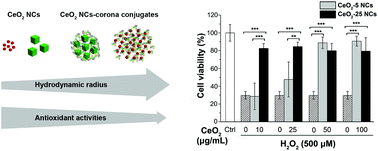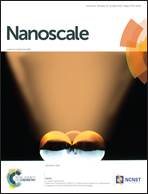Hydrophilic CeO2 nanocubes protect pancreatic β-cell line INS-1 from H2O2-induced oxidative stress†
Abstract
Oxidative stress plays a key role in the occurrence and development of diabetes. With their unique redox properties, CeO2 nanoparticles (nanoceria) exhibit promising potential for the treatment of diabetes resulting from oxidative stress. Here, we develop a novel preparation of hydrophilic CeO2 nanocubes (NCs) with two different sizes (5 nm and 25 nm) via an acetate assisted hydrothermal method. Dynamic light scattering, zeta potential measurements and thermogravimetric analyses were utilized to investigate the changes in the physico-chemical characteristics of CeO2 NCs when exposed to in vitro cell culture conditions. CCK-8 assays revealed that the CeO2 NCs did not impair cell proliferation in the pancreatic β-cell line INS-1 at the highest dose of 200 μg mL−1 over the time scale of 72 h, while being able to protect INS-1 cells from H2O2-induced cytotoxicity even after protein adsorption. It is also noteworthy that nanoceria with a smaller hydrodynamic radius exhibit stronger antioxidant and anti-apoptotic effects, which is consistent with their H2O2 quenching capability in biological systems. These findings suggest that nanoceria can be used as an excellent antioxidant for controlling oxidative stress-induced pancreatic β-cell damage.


 Please wait while we load your content...
Please wait while we load your content...